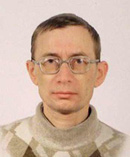Contents: 2024 | 2023 | 2022 | 2021 | 2020 | 2019 | 2018 | 2017 | 2016 | 2015 | 2014 | 2013 | 2012 | 2011 | 2010 | 2009 | 2008 | 2007 | 2006 | 2005 | 2004 | 2003 | 2002 | 2001
2017, 4
Atomic Na emission during sonoluminescence from aqueous solutions of different types of surfactants
language: Russian
received 18.10.2017, published 19.11.2017
Download article (PDF, 418 kb, ZIP), use browser command "Save Target As..."
To read this document you need Adobe Acrobat © Reader software, which is simple to use and available at no cost. Use version 4.0 or higher. You can download software from Adobe site (http://www.adobe.com/).
ABSTRACT
Sonoluminescence (SL) is light emission under high-temperature and high-pressure conditions of a cavitating bubble under intense ultrasound in liquid. The mechanisms involved in the atomic metals emission during SL from the solutions of the nonvolatile metals compounds are still under debate. The present study examines the emission from electronically excited sodium atoms and includes two aspects: (1) the line shape in SL spectra from argon saturated aqueous solutions of alkyl sulfates with different carbon-chain length (CnH2n+1SO4Na, n=1, 12, 14), and (2) the influence of different surfactants on the intensity of Na emission from argon saturated aqueous NaCl solutions. The shape of Na line in SL spectra consists of the broad asymmetrically shifted component and the unshifted narrow doublet. The broad component is considered to result from highly compressed cavitating bubble content. The origin of narrow component is unclear. The study showed for sodium methyl sulfate (n=1) the line shape was the same as that in spectra from NaCl solutions and showed mainly the broad component. For surfactants with long carbon-chain (n= 12, 14) the broad component was suppressed while the narrow one was well-marked. It is known that the intensity of Na emission in SL spectra from anionic surfactants solutions is much higher than in the spectra from NaCl solutions. The offered explanation is the forming an electrostatic surface potential which attracts Na+ ions to the bubble surface. Present study showed that the presence of any type of surfactants (anionic, cationic, zwitterionic, nonionic) had been leading to the rise of intensity of Na emission. The effect was most significant for the anionic and nonionic surfactants and increased with the growth of NaCl concentration. The results was interpreted in terms of changing of dynamic properties of the bubble surface due to presence of surfactants.
9 pages, 3 figures
Сitation: T. Gordeychuk, M. Kazachek. Atomic Na emission during sonoluminescence from aqueous solutions of different types of surfactants. Electronic Journal “Technical Acoustics”, http://www.ejta.org, 2017, 4.
REFERENCES
1. Suslick K.S., Eddingsaas N.C., Flannigan D.J., Hopkins S.D., Xu H. Extreme conditions during multibubble cavitation: Sonoluminescence as a spectroscopic probe // Ultrason. Sonochem. - 2011. - V. 18. - P. 842-846.
2. Choi P.-K., Hayashi Y. Two components of Na emission in sonoluminescence spectrum from surfactant aqueous solutions // Ultrason. Sonochem. - 2015. - V. 23. - P. 333-338.
3. Hayashi Y., Choi P.-K. Effects of Rare Gases on Sonoluminescence Spectrum of the K Atom // J. Phys. Chem. B - 2012. - V. 116. - P. 7891-7897.
4. Казачек М.В., Гордейчук Т.В. Изменение формы атомных линий щелочных металлов в спектрах сонолюминесценции растворов поверхностно-активных соединений и галогенидов// Письма в ЖТФ. - 2013. - Т. 39, № 21. - С. 76-85.
5. Гордейчук Т.В., Казачек М.В. Влияние частоты ультразвука на форму D-линии Na в спектрах сонолюминесценции водных растворов хлорида и додецилсульфата натрия// Письма в ЖТФ. - 2014. - Т. 40, № 23. - С. 31-40.
6. Казачек М.В., Гордейчук Т.В. Одна простая модель формы D-линии Na в спектрах сонолюминесценции // Письма в ЖТФ. - 2011. - Т. 37, № 6. С. 39-48.
7. Chu H.-C., Vo S., Williams G.A. Precursor Luminescence near the Collapse of Laser-Induced Bubbles in Alkali-Salt Solutions // Phys. Rev. Let. - 2009. - V. 102. - P. 204301-1.
8. An Y., Li Ch. Diagnosing temperature change inside sonoluminescing bubbles by calculating line spectra // Phys. Rev. E. - 2009. - V.80. - P. 046320-1.
9. Sostaric J., Ashokkumar M., Grieser F. Sodium Atom Emission from Aqueous Surfactant Solutions Exposed to Ultrasound // Langmuir. - 2016. - V. 32. - P. 12387-12393.
10. Xu H., Eddingsaas N.C., Suslick K.S. Spatial Separation of Cavitating Bubble Populations: The Nanodroplet Injection Model // J. Am. Chem. Soc. - 2009. - V. 131. - P. 6060-6061.
11. Гордейчук Т.В., Казачек М.В. Экспериментальное наблюдение интенсивного роста сонолюминесценции металлов под влиянием давления и температуры // Оптика и спектроскопия. - 2009. - Т. 106, № 2. - С. 274-277.
12. Донцов В.Е. Процессы растворения и гидратообразования за ударной волной в жидкости с пузырьками из смеси азота и углекислого газа при наличии поверхностно-активного вещества // Теплофизика и аэромеханика. - 2009.- Т. 16, № 1. - С. 89-101.
13. Brenner M.P., Hilgenfeldt S., Lohse D. Single-bubble sonoluminescence // Rev. Mod. Phys. - 2002. - V. 74. - P. 425-484.
14. Неволин Ф.В. Химия и технология синтетических моющих средств // М.: Пищевая промышленность. - 1971
 |
Tatyana Gordeychuk – PhD, V.I.Il'ichev Pacific Oceanological Institute, Far Eastern Branch of RAS (https://www.poi.dvo.ru/drupal/en), Vladivostok, Russia, senior researcher G.I.Nevelskoy Maritime State University, Vladivostok, Russia. assistant professor. The area of scientific interests - physical acoustics, physical and biological effects of ultrasound, cavitation, sonoluminescence. |
|
 |
Mikhail Kazachek – PhD, V.I.Il'ichev Pacific Oceanological Institute, Far Eastern Branch of RAS (https://www.poi.dvo.ru/drupal/en), Vladivostok, Russia. Senior researcher. The area of scientific interests - spectroscopy, quantum chemistry, sonoluminescence. |
|
